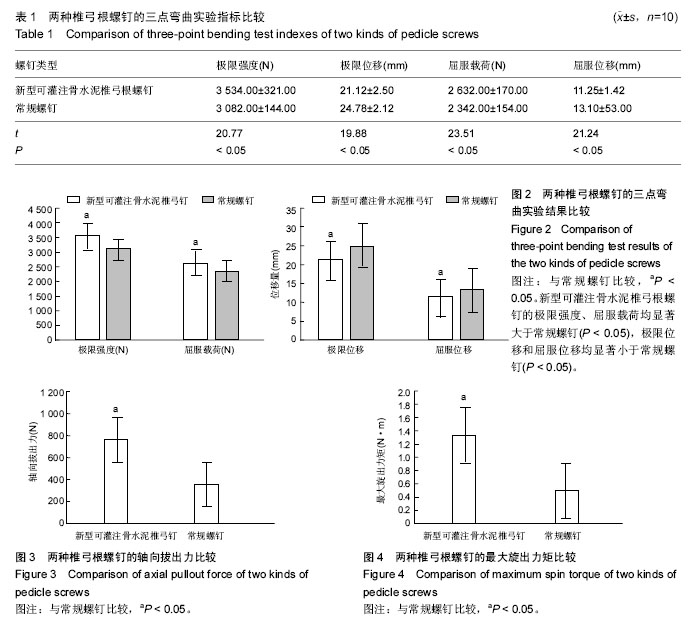中国组织工程研究 ›› 2016, Vol. 20 ›› Issue (31): 4671-4676.doi: 10.3969/j.issn.2095-4344.2016.31.016
• 骨与关节生物力学 bone and joint biomechanics • 上一篇 下一篇
新型可灌注骨水泥椎弓根螺钉的生物力学性能及在骨质疏松性腰椎退变中的应用
刘 扬,刘 丹,肖运祥,陈海丹,赵红卫
- 三峡大学第一临床医学院,宜昌市中心人民医院脊柱外科,三峡大学脊柱医学与创伤研究所,湖北省宜昌市 443000
Biomechanical properties of a novel pourable cement pedicle screw and its application to osteoporotic lumbar degeneration
Liu Yang, Liu Dan, Xiao Yun-xiang, Chen Hai-dan, Zhao Hong-wei
- First Clinical Medical College of China Three Gorges University, Department of Spine Surgery of Yichang Central People’s Hospital, Institute of Spinal Medicine and Trauma of China Three Gorges University, Yichang 443000, Hubei Province, China
摘要:
文章快速阅读:
.jpg)
文题释义:
椎弓根螺钉:类同于一般骨螺钉,需要螺钉周围骨质紧密把持获得稳定性。但是,对于骨质疏松症患者而言,钉道周围骨质脆弱,难以把持椎弓根螺钉,容易造成椎弓根螺钉的松动或拔出,导致内固定失效或假关节形成,部分学者将其视为禁忌证。
新型可灌注骨水泥椎弓根螺钉:和常规螺钉相比优势较多,该螺钉最主要的创新性在于特殊设计的螺钉内部的中空部分和远端螺钉处的侧孔分布,并且采用相应的配套设计的骨水泥推杆和灌注筒,保证螺钉和骨水泥的结合时操作更加简单,具有更强的操作性。
摘要
背景:老年性骨质疏松患者由于机体骨质的脆弱,容易造成椎弓根螺钉固定能力得到进一步削弱。因此骨质疏松性腰椎退变患者采用椎弓根螺钉修复时骨水泥渗漏以及螺钉取出量等问题难以解决。
目的:探讨新型可灌注骨水泥椎弓根螺钉的生物力学性能及在骨质疏松性腰椎退变患者中的应用效果。
方法:选取完整浸润腰椎标本(T11-L5)6具,平均年龄(72.9±4.2)岁,共42个椎体,平均骨密度为0.696 g/cm2。所有椎体任意选取一侧椎弓根置入可灌注骨水泥椎弓根螺钉,采用水泥推杆和灌注筒在X射线透视下灌注2 mL骨水泥;在椎体标本对侧置入相同数目常规螺钉。对2种螺钉进行三点弯曲实验,对选取椎体进行最大轴向拔出力实验及最大旋出力矩实验,观察椎体的破坏情况及螺钉置入效果。
结果与结论:①新型可灌注骨水泥椎弓根螺钉极限强度、屈服载荷均显著大于常规螺钉(P < 0.05);极限位移和屈服位移均显著小于常规螺钉(P < 0.05);②新型可灌注骨水泥椎弓根螺钉的轴向拔出力及最大旋出力矩均显著高于常规螺钉(P < 0.05);③综上所述,新型可灌注骨水泥椎弓根螺钉操作简单,能够有效的控制骨水泥渗透,提高螺钉在骨质疏松椎体内的稳定性,且治疗后螺钉取出相对方便,不会对椎体和钉道产生明显的破坏,促进机体早期恢复。
中国组织工程研究杂志出版内容重点:人工关节;骨植入物;脊柱;骨折;内固定;数字化骨科;组织工程
ORCID: 0000-0001-7077-0455(刘扬)
中图分类号:

.jpg)
.jpg)